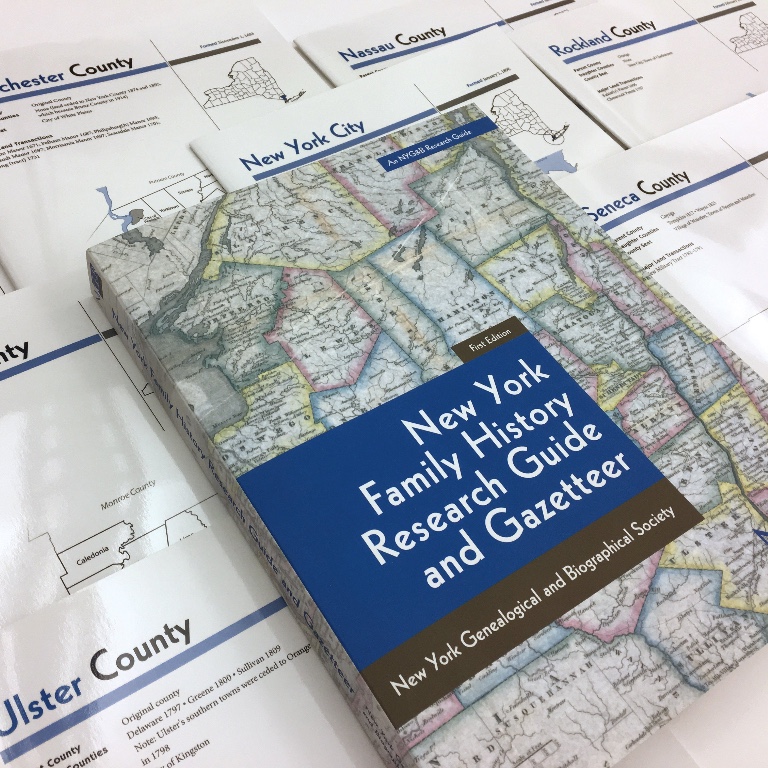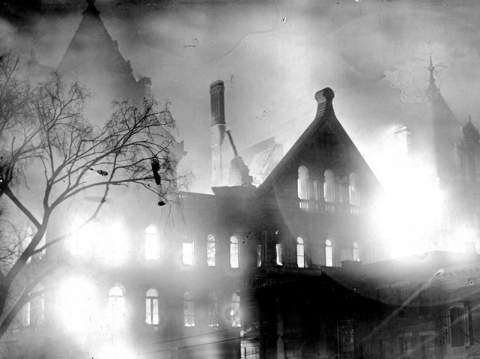Sooner or later, all researchers encounter the sad fact that a massive fire destroyed a crucial piece of evidence in their family history.
Almost everyone knows about the 1921 Washington, D.C. fire that destroyed much of the 1890 Federal Census, and those of us with ancestors who served in the military are probably aware that a 1973 fire in St. Louis destroyed between 16 and 18 million Official Military Personnel Records.
But did you know that New York State has its own infamous fire?
In 1911, a fire in New York's State Capitol, Albany, destroyed an enormous amount of crucial historical and genealogical records. Read on to learn about the fire, see some of the astounding pictures, and learn about what was destroyed. We'll also detail two heroes of the fire, who saved countless precious historical resources from destruction in the days after.
Harry Macy Jr. wrote about this event and its impact on New York genealogy in the Spring 1999 issue of the NYG&B Newsletter (later renamed the New York Researcher) - this blog is based on that article, The 1911 State Library Fire And Its Effect On New York Genealogy, which is available for NYG&B members to read in the New York Knowledge Base.
This blog will outline the story of the fire itself and the heroes involved; Harry Macy Jr.'s article goes into incredible depth describing the exact documents lost, along with suggestions for substitutes where possible.
The New York State Library in 1911
At the time of the fire the Library was housed in the State Capitol, the same monumental building which is home to the Governor and Legislature today:

Image via Wikimedia Commons.
At the beginning of the 1900s, the New York State Library was the 5th largest library in the United States, and among the largest libraries in the entire world.
Back then, the State Archives was not a separate entity, so the State Library also held many important state government records, including invaluable documents dating all the way back to colonial New Netherland.
Tragically, the Library and all its materials were scheduled to move to a new building on January 1, 1911. But due to construction delays, all materials were still in the Capitol building on March 29, when catastrophe struck.
Fire!
As you can see from the image above, the State Capitol building is enormous - had the fire started in a remote corner of the building, far from the treasured material, things may have turned out better. But unfortunately, the fire initially broke out just after midnight on March 29, on the same floor as the State Library.
Here is one of the few photographs taken during the early hours of the blaze:

Photo reproduced with permission from the collections of the New York State Library, Manuscripts and Special Collections, Albany, New York.
Harry Macy's 1911 State Library Fire And Its Effect On New York Genealogy describes the disaster:
When the Fire Department arrived, the Assembly Library was totally engulfed, and flames had burst through the adjacent corridor into the State Library. By 4 a.m. the fire was described as "a total inferno."
Despite the hour, crowds gathered to watch. Sheets of scorched paper from books and historical manuscripts filled the sky over Albany "like snowflakes," and would drift to earth over a 20-mile radius.
After sunrise, when the fire had been brought under control, smoke continued to pour from the windows. The firefighters had saved much of the building, but the Library appeared to be a total loss.
Indeed, during the conflagration, not a single book could be rescued from the Library proper. The fire destroyed:
- 450,000 books
- 270,000 manuscripts
- The entire catalog of almost 1,000,000 cards.
It was truly one of the greatest library disasters of modern times.

Photo reproduced with permission from the collections of the New York State Library, Manuscripts and Special Collections, Albany, New York.
In the morning, the State Militia was called in and surrounded the building to prevent looting. Firefighters worked tirelessly to extinguish the last parts of the fire.

Photo reproduced with permission from the collections of the New York State Library, Manuscripts and Special Collections, Albany, New York.
The recovery process
As soon as the building was safe to enter, the recovery effort began. Some material was burned completely, but even more suffered damage from smoke or the water from the firefighters' hoses. Even many volumes that escaped the flames were severely damaged:

Photo reproduced with permission from the collections of the New York State Library, Manuscripts and Special Collections, Albany, New York.
Several staff members of the State Library should be remembered as heroes to modern-day researchers: Without their swift efforts, far more history would have been lost. A.J.F van Laer, who had been the State Archivist for 12 years, was joined by noted antiquarian I.N. Phelps Stokes, who came to Albany from the New York Public Library to help. The two, undertook a painstaking rescue process to preserve what they could.
Another man who played a major role in the rescue operation was Joseph Gavit, a librarian who had worked at the State Library since 1896. At the time of the fire, he was superintendent of the stacks, and he knew the labyrinth of shelves and books like the back of his hand.

Photo reproduced with permission from the collections of the New York State Library, Manuscripts and Special Collections, Albany, New York.
Gavit reportedly knew where every book was located and was instrumental in quickly recognizing volumes that looked (to others) damaged beyond identification:

Photo reproduced with permission from the collections of the New York State Library, Manuscripts and Special Collections, Albany, New York.
What was lost
Although the Library's card catalog was destroyed, several sources exist that allow us to create a list of materials lost.
Researchers will want to examine Harry Macy Jr.'s New York Knowledge Base article, 1911 State Library Fire And Its Effect On New York Genealogy for an excellent synthesis of these sources and a clear description of what was lost, how any saved volumes may be access, or how it may be substituted (if possible).
Here is a general overview:
- State Censuses
- Marriage Bonds
- Colonial Manuscripts
- English Colonial Council Minutes
- Colonial Commissions
- Records relating to the frontier and native people of New York
- Rensselaerswyck manuscripts & Van Rensselaer family papers
- Revolutionary War records
- Compiled genealogies
Not all of these records were completely destroyed, and in many cases, additional copies and substitutes may be located elsewhere. See the full 1911 State Library Fire And Its Effect On New York Genealogy article for more details.
More photos of the State Library fire of 1911
The original 1911 photos in this article were reproduced with permission from the New York State Library, Manuscripts and Special Collections division.
If you're interested in learning even more about the fire, the New York State Museum has a fantastic digital exhibit online: The 1911 Capitol Fire. Their exhibit contains dozens of more images and more information about the events of March 29.
More Genealogy Reading
-
11 Ways to use the NYG&B website to improve your skills and find ancestors
-
Why you need to have your ancestor's New York death certificate
-
Researching Irish ancestors in New York State: What you need to know
-
7 resources to get you started with genetic genealogy
-
Surprising facts about immigration to New York
-
Finding Birth, Marriage, and Death Records in New York State
About the New York Genealogical and Biographical Society

back-to-back Awards of Excellence from
the National Genealogical Society
in 2016 and 2017.
Since 1869, the NYG&B's mission has been to help our thousands of worldwide members discover their family's New York story, and there has never been a better time to join.
The cost of an Individual Annual Membership is less than six dollars a month, and includes the following benefits:
- Access to over 50 exclusive digital record sets covering the entire state of New York, including the fully searchable archives of The Record.
- A complimentary subscription to all of Findmypast's North American records, as well as U.K. and Irish Census records.
- Access to hundreds of expert-authored Knowledge Base articles and webinars to help you navigate the tricky New York research landscape.
- Exclusive discounts and advanced access to conferences, seminars, workshops and lectures to learn more about researching people and places across New York State.
To learn more or join us, please visit our member benefits page
